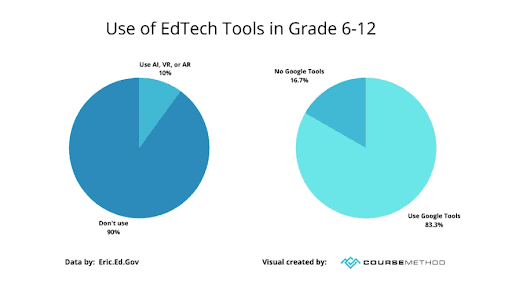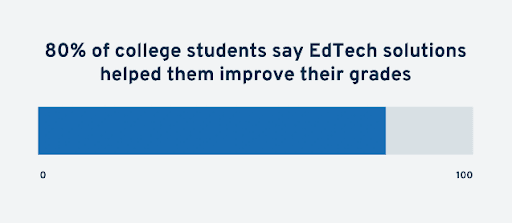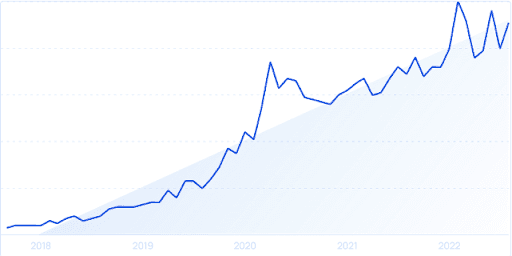The Ed-tech market is expanding significantly at a 17.79% CAGR and is expected to grow by 133.05 billion USD between 2021 and 2026. Keeping your business up-to-date is a necessity. Therefore, this post compiles more than 30 compelling statistics about the EdTech industry to help you visualize where things are going.
What is the current state of education technology, and what will it look like in the future?
Keep reading to find out:
Content:
- Outstanding Edtech Industry Stats
- Key companies in Edtech Industry
- General Edtech Statistics
- The new trend of MOOCs – Massive Open Online Course Stats
- The evolution of 3 key segments of the Edtech industry
Outstanding Edtech Industry Stats
- The EdTech market is valued at $254 billion.
- The corporate education technology industry is worth $22.5 billion.
- Since 2020, the use of educational technology in K-12 schools has increased by 99%.
- In the next three years, more than 70% of colleges expect to launch one or more online undergraduate programs.
- The most popular corporate skill-building strategy is digital learning.
Key Companies in Edtech Industry
The following are the fastest-growing EdTech companies worldwide for the year 2021-2022:
- BYJU’S
- Blackboard Inc.
- Chegg, Inc.
- Coursera Inc.
- Edutech
- edX Inc.
- Google LLC
- Instructure, Inc.
- Microsoft
- Udacity, Inc.
- upGrad Education Private Limited
In addition, there are a number of Ed-tech companies earning billions. These include Kahoot! with a valuation of 39.3 billion (Yahoo Finance), Yuanfudao with a valuation of $15.5 billion (Edtechreview), BYJU’S worth an estimated $12 billion (Wikipedia), Chegg, Inc worth an estimated $11.5 billion (Yahoo Finance), and Udemy estimated at $3.3 billion (Techcrunch).

General Edtech statistics
1. Google Trends for EdTech shows an increase in searches for the term ‘ed-tech’ between the Fall of 2021 and 2022. (Google Trends)

2. By 2027, the EdTech industry is expected to be worth $605.8 billion USD. This is an increase from 254.80 billion US dollars in 2021. (Global Newswire)
3. The adaptive learning market is expected to be worth $9.11 billion by 2028. (Emergen Research)
Educators have discovered that getting the best results requires adapting to each student’s different personality and needs. For example, Elevate which is a brain-training app helps users learn more effectively by providing personalized content.
4. The global virtual reality (VR) headset market is expected to reach 26.8 billion US dollars in 2027. This is an increase from 7.7 billion US dollars in 2020. (Valuates.com)
5. By 2027, the interactive whiteboard market is expected to be worth $2.8 billion. This is an increase from the $1.6 billion market size in 2020. (According to Grandview Research)
6. The global 3D printing market is expected to grow from $12.6 billion in 2021 to $35.4 billion by 2027. (Future Market Research)
7. The market for learning management systems (LMS) is expected to reach 42 billion US dollars by 2027. (From the Global News Wire)

The new trend of MOOCs – Massive Open Online Courses (MOOCs)
The Massive Open Online Course (MOOC) provides free online courses to anyone anywhere in the world. In 2019, the MOOC industry was worth 5.2 billion US dollars. Then, it is expected to be worth 21.1 billion US dollars by 2025. (SDKI.JP)

While MOOC completion rates can reach 30%, the average completion rate is often only around 15%. This is most likely due to the fact that they are free. (Katy Jordan)

Coursera, a typical success case of MOOC, was valued at nearly $750 million (Edsurge). As one of the top five MOOC leaders, Coursera is providing over 3,800 courses serving 45 million students. It offers 16 different degrees, including Bachelor’s and Master’s degrees. (From Class Central)
Other top 5 MOOC providers include edX, which has helped 24 million learners through 2,640 courses, Udacity, which has helped 11.5 million learners through 200 courses, FutureLearn, which has helped 10 million learners through 880 courses, and Swayam, which has helped 10 million learners through over 1,000 courses. (From Class Central)

11. 80% of MOOC participants have a Bachelor’s degree or higher. In addition, 60% are from developed countries, and nearly 60% work full-time. (HBR.org)
Read more: How to Create an Effective E-Learning Product in 2022
The evolution of 3 key segments of the Edtech industry
K-12 Edtech Statistics
K-12, a term used in education and educational technology, is a short form for the public school grades before college. Kindergarten (K) and first through twelfth grades are included (1-12).
During the Covide pandemic, schools were forced to scramble to adapt to Ed-tech. As the result, today’s teachers and students have firsthand experience with the benefits and challenges that technology brings. Below are several figures about the K-12 Edtech market.
Read more: How Covid 19 changed Education Industry by Digital Transformation
1. In education, personalized learning is gaining attention.
Personalized learning is viewed as a “promising idea” by approximately 50% of K-12 educators. In K-12 schools, 21% believe it has the potential to be fully applied at school, 11% consider it a passing fad, while 10% say it is not something they consider at all. 8% consider it a threat to public education. (Edweek)

2. 83% of students in grades 6-12 reported using Google tools at least once a week to complete schoolwork. (Eric.ed.gov)

3. 58% of parents with children in grades K-12 believe that incorporating technology into their children’s schoolwork is a good way for them to learn. According to 82% of parents, using technology in school is important for their child’s future. (Eric.ed.gov)
4. During the pandemic, 87% of K-12 educators say their technological skills improved (EdWeek)
During the peak of the COVID-19 pandemic, many teachers were frustrated by widespread closures. Many people, however, claim that being forced to adapt makes them more tech-savvy. Today’s teachers are more at ease in combining technology and face-to-face instruction
5. On average, US K-12 school districts use 1403 EdTech solutions per month (Learn Platform)
Classroom engagement and instruction platforms such as Kahoot! and Quizizz account for 23% of all K-12 ed-tech solutions. General solutions such as Google’s suite of programs (Docs, Slides, Drives, and so on) account for 18%

6. 3 out of 5 K-12 teachers intend to continue giving online assignments after the pandemic (Christensen Institute)
While most teachers intend to reduce the use of technology in the classroom following the pandemic, they are eager to keep some practices. 61% plan to keep online assignments. Only 47% of K-12 teachers assigned online coursework prior to the pandemic.
7. Following the pandemic, one-third of K-12 school systems will offer fully remote learning. (Christensen Institute)
Full-time virtual schools were created in response to a public health crisis. However, some school districts want to keep the option in the future. Others intend to continue providing supplemental online courses or to establish student learning hubs.
College EdTech Statistics
Another aspect of the Ed-tech market is College Edtech.
Online degree programs have existed since the dawn of the internet. However, Ed-tech can benefit all college students by providing new ways for them to learn, study, and communicate. The following are some figures related to Ed-tech in College.
1. 4 out of 5 college students say EdTech solutions have helped them improve their grades. (McGraw-Hill)

College students are getting a lot out of Ed-tech. More than 80% believe EdTech helps them improve their grades, spend more time studying, and learn more effectively. They also believe that more progress can be made — 84% believe that EdTech could be used more effectively.
2. 9 out of 10 college students believe that EdTech solutions should be tailored to their preferred learning style (McGraw-Hill)
Specifically, personalization is “extremely important” to 49% of students, who agree that adaptive learning technology is the best. 66% believe adaptive technology, such as personalized quizzes, aids in learning and retention.
3. Gamification based on challenges has been shown to improve student outcomes by up to 35%. (International Journal of Human-Computer Studies)
Gamification allows students to interact with topics in ways that traditional lectures cannot. Gamification, it turns out, produces results. Combining gamification and reading can increase performance by up to 60%.
4. In the next three years, more than 70% of colleges expect to launch one or more online undergraduate programs. (Wiley)
As online education becomes the preferred method of enrollment for many students, the demand for new online degree programs continues to rise. In fact, more than half of online college students say they would drop out if their preferred school did not offer an online program.
5. 74% of college students desire mobile access to course materials. (Wiley)

6. Less than 1 out of 8 college students have enrolled in a massively open online course (MOOC) (Wiley)
MOOCs such as Coursera and Udemy have yet to catch on with college students. Only 13% of people say they’ve ever taken a free course. 4% have not yet enrolled but intend to do so within the next year.
Read more: Redefine the Role of Technology in Education with E-learning
Corporate EdTech Statistics
After college, learning does not end. To advance in their careers, professionals must constantly improve. EdTech solutions assist organizations in honing the hard and soft skills of their workforce.
1. The corporate education technology industry is worth $22.5 billion (Valuates)
By 2026, the corporate EdTech industry could be worth $37 billion (Valuates)
Over the next half-decade, the market for corporate education technology could more than double. While North America holds the majority of the EdTech market, Europe and the Asia-Pacific region are expected to grow faster this decade.
Corporate training and development is a costly expense for many businesses. Companies can use EdTech to upskill their workforce in less time and for less money. Industry leaders include Oracle, Skillsoft, and Blackboard.
2. Employee training costs businesses an average of $1,308 per employee per year (ATD)
Companies invest heavily in employee training and development. EdTech has the potential to reduce those costs by making learning more effective and efficient.
3. After only 7 days, the average worker forgets 65% of the material they’ve covered (Intuition)
Workers forget up to 90% of the material covered in traditional workplace training after 6 months. This creates enormous opportunities for EdTech companies that can increase those numbers.

4. The most popular corporate skill-building strategy is digital learning (McKinsey)
Upskilling is a major focus in the business. Following the pandemic, 58% of businesses say closing the skills gap is a high priority. 69% have increased their skill-building efforts. 75% believe that digital learning is the most effective channel for skill development.
5. Over the next year, 41% of training professionals intend to invest in learning management systems (LMS).(Training)
Organizations can use learning management systems to streamline their learning and development strategies. So, companies can save money on expensive training materials by going mobile and digital, while employees have the freedom to upskill on the go.

6. 76% of employees say they are more likely to stay with employers who provide opportunities for upskilling (Talent LMS)

Employees enjoy acquiring new skills on the job. Employees recommend making training content more relevant, keeping it up to date, and incorporating a social component to improve learning and development.
CONCLUSION
With technology becoming more widespread in classrooms on a daily basis, it will be fascinating to see how the education industry evolves and what new technologies emerge as key players in the field.
If you want to explore the Edtech industry or start a new business app in education, contact icts.io to book a FREE consultation meeting




0 Comment